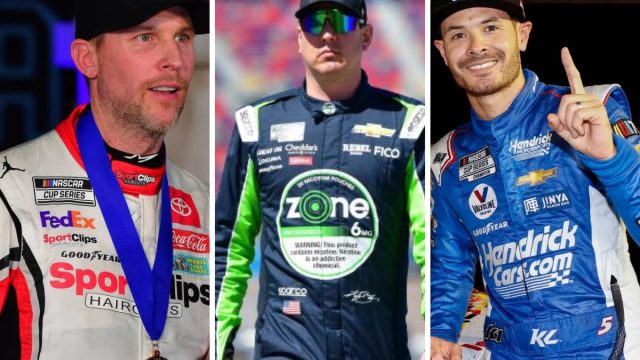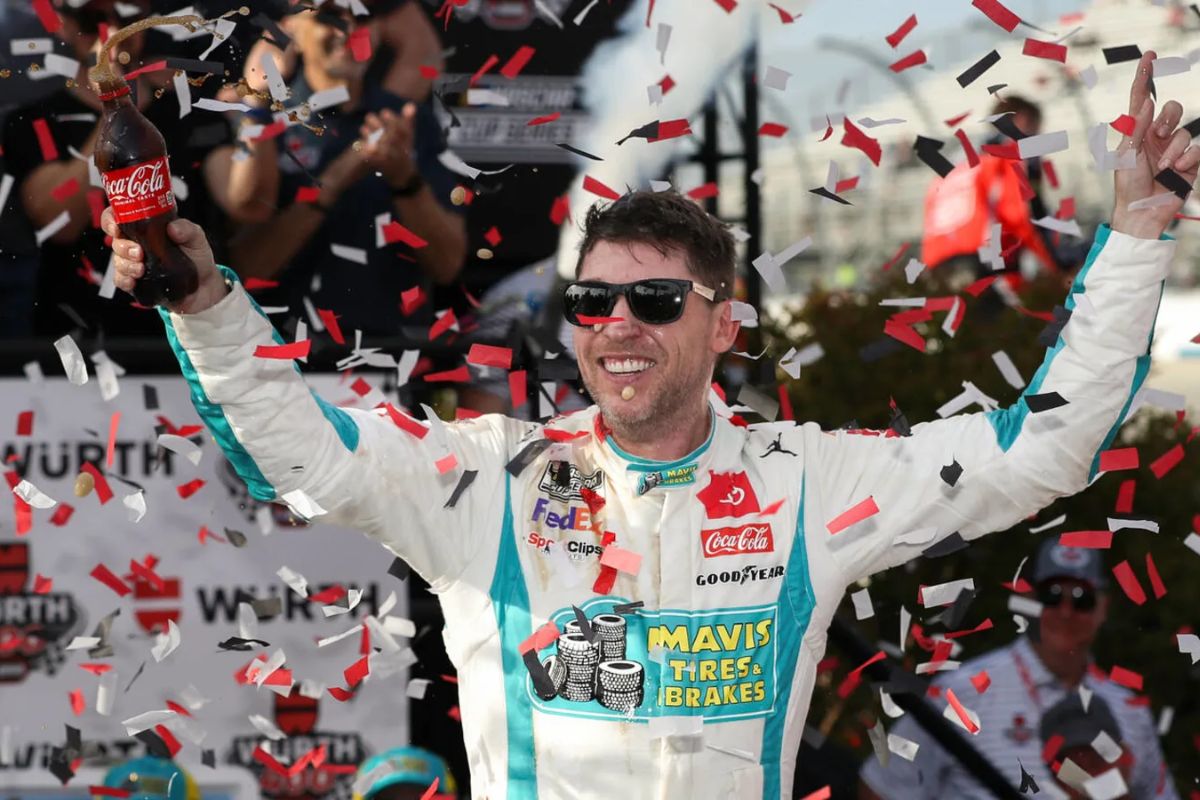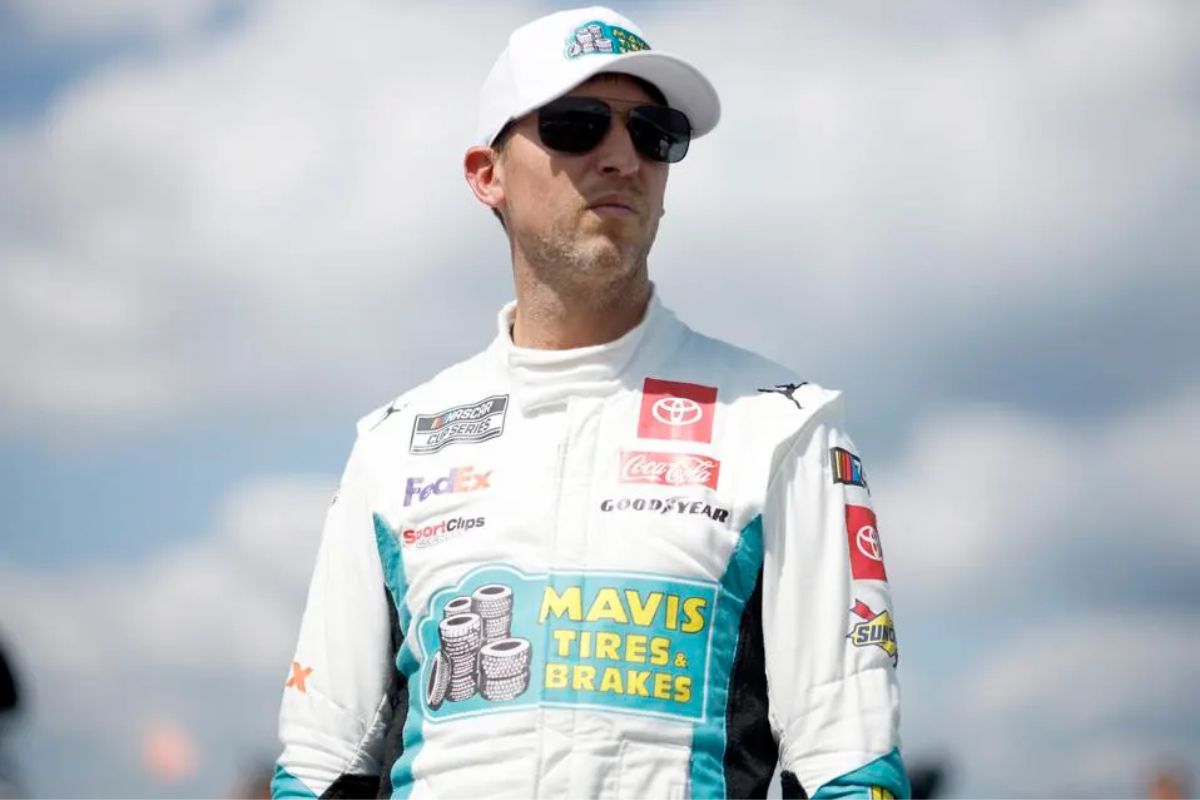Denny Hamlin Silences Busch and Larson: In a riveting turn of events at the Wurth 400 in Dover, Denny Hamlin not only clinched a decisive victory but also countered the pointed criticisms from rivals Kyle Busch and Kyle Larson. The disagreement centers around the purported aerodynamic blocking tactics that Hamlin was accused of exploiting, a strategy that both Busch and Larson argue undermines racing integrity. Hamlin’s rebuttal emphasized the traditional defensive strategies inherent in NASCAR’s legacy, demanding for substantial modifications to the Next-Gen cars to diminish aerodynamic dependency.
Key Takeaways
- Denny Hamlin won the 2024 Wurth 400 at Dover, utilizing advanced aerodynamic strategies.
- He used effective aero-blocking to disrupt Kyle Larson’s performance, securing his victory.
- Hamlin dismissed criticism from Kyle Busch and Larson, attributing their comments to common grievances.
- He advocated for NASCAR to modify Next-Gen cars to reduce aerodynamic dependencies.
- Hamlin emphasized the importance of driver skill and strategic pit stops in his win at Dover.
Denny Hamlin’s Victory at Dover
Denny Hamlin’s dominant performance at the 2024 Wurth 400 in Dover not only secured his third Cup Series points race victory but also sparked a debate on the strategic evolution within the Next-Gen race cars. This win, undeniably a demonstration of skill and strategic expertise, places Hamlin in a unique spotlight, highlighting the adaptive strategies drivers are employing with the new car specifications.
The Next-Gen cars, introduced to improve competition and safety, have indeed reshaped racing dynamics. Hamlin’s victory at Dover is a confirmation of his mastery of these vehicles, characterized by their advanced engineering and altered aerodynamics. Observing his race, it was evident that his approach was not just about speed but also about leveraging the car’s responsiveness to track conditions and tire management.
Hamlin’s adaptability was on full display as he navigated the high-banked, one-mile oval, a track known for its physically demanding nature and the precision it demands from drivers. The #11 team’s pit strategy was impeccable, opting for timely stops that optimized the car’s performance during key segments of the race.
Aero-Blocking Strategy
At the Wurth 400, the aero-blocking strategy emerged as an important defensive tactic, particularly advantageous on Dover’s high-banked, mile-plus track. This method involves a leading car manipulating airflow to compromise the trailing car’s aerodynamic efficiency, effectively impeding their ability to overtake. The technique exploits the Gen 7 cars’ sensitivity to aerodynamic disturbances, making precision in its execution a key factor in race outcomes.
Denny Hamlin’s adept use of aero-blocking during the final stages of the Wurth 400 highlighted the strategic depth required in modern motorsports. By strategically positioning his vehicle, Hamlin was able to disrupt the airflow necessary for Kyle Larson’s car to maintain ideal downforce and grip. This defensive positioning is particularly effective at Dover International Speedway due to its unique combination of high speeds and tight cornering, where maintaining a dominant line can greatly deter passing opportunities.
Driver Frustrations
The mounting frustrations among drivers, particularly Kyle Busch and Kyle Larson, stem from perceived aerodynamic disadvantages exacerbated by the aero-blocking tactics employed during the Wurth 400 at Dover International Speedway. Larson, a notable critic and master of the aero block himself, dismissed Hamlin’s victory as effortless, attributing it to unchallenged aerodynamic manipulations rather than competitive racing skill. His call to eliminate rear-view cameras underlines a critical aspect of contemporary racing strategy—these devices potentially consolidate a leader’s advantage by facilitating more effective blocking tactics, particularly in single-file lineups where overtaking opportunities are already scarce.
Further complicating the discourse, Busch, who secured a top-five finish, voiced his discontent regarding his Joe Gibbs Racing teammate, Martin Truex Jr., who he felt hindered his progress during the race. He described Truex’s pace as ‘slower’, posing a significant threat to his own race strategy by nearly causing collisions during critical overtaking moves off of Turn 2. This inter-team rivalry highlights a broader issue of competitive dynamics and strategic alignment within teams, which can significantly impact individual race outcomes.
Denny Hamlin’s Response
In addressing the widespread criticism following his victory at Dover, Denny Hamlin firmly dismissed the significance of aero blocking as a determinant in his performance, attributing the controversy primarily to habitual grievances that surface whenever he secures a win. Hamlin’s rebuttal was not just a defensive reflex but a calculated dismissal of the notion that aero blocking played a crucial role in his recent success. On the podcast ‘Actions Detrimental,’ when probed about the impact of aero blocking, Hamlin retorted with a reference to consistent criticisms that arise with each of his victories, emphasizing a pattern of discontent emerging from competitors and spectators alike.
“I think that I won and so there’s just gonna be b*tching. It was the restart at Richmond. It’s just always something… They asked me in the media center when I felt it started. I thought it started back in 2019 when we were running the big-a** spoilers in the 550 package on the mile and a halfs’.”-Denny
His perspective is deeply rooted in the history and evolution of racecraft in NASCAR. Citing the 2020 Kansas race where Joey Logano famously held off Kevin Harvick, Hamlin highlighted this as the genesis of a more pronounced awareness and strategic use of defensive driving techniques among teams and drivers. He paralleled aero blocking with ‘mirror driving,’ a longstanding tactic utilized mainly at superspeedways. This analogy emphasizes his argument that these techniques are ingrained in the sport’s competitive fabric and are indispensable to a driver’s tactical arsenal.
“Aero-blocking is the same… it’s been around forever and you’re not gonna change it.”-denny
Hamlin’s discourse extended to address specific suggestions about potential rule changes aimed at mitigating aero blocking, particularly dismissing Kyle Larson’s insinuations about the efficacy of removing in-car cameras to curb the practice. He pointed out the minimal role these cameras play during races, emphasizing the essential role of spotters in guiding drivers’ actions. His firm stance was represented in his assertion that no regulatory adjustments could eradicate practices that drivers deem best for guarding their positions or clinching victories, thus heralding the futility of such interventions.
“There’s no rules that you can make to change it. I saw where Kyle Larson I think said, ‘Well, you know, if they took the camera away.’ For me, I looked at the camera a few times during the race. But not very often unless I was just kinda checking my gap on a restart. So that’s certainly not gonna fix it, as long as we have spotters kinda telling us where to go. Which we gotta have those…”-denny
Parity Concerns and Future Changes
Denny Hamlin’s proactive stance on the need for significant changes in NASCAR’s Next-Gen vehicle highlights a broader concern about parity within the sport. His insights have stemmed from firsthand frustrations with the vehicle’s performance under different racing conditions. Hamlin’s call for a ‘bigger variant in speed of cars’ is not just about enhancing competition but fundamentally about restoring the competitive integrity of races. The essence of his argument lies in adjusting the vehicle dynamics so that the race outcomes aren’t mostly decided by external factors such as cautions and restarts, but by genuine racing skill and team strategies.
“What you have to do. The only way to get rid of this is to make it to where there’s lap time variants. That second car is just so much faster than the first car, that he’s gonna get around no matter how much you choose to aero block. You shouldn’t be able to swerve in the middle of the corner and hold somebody off. So I think that you’ve got to have a bigger variant in speed of cars. That’s the only way we’re gonna get rid of this in the long run…”-denny
Is there a way to stop drivers from mirror driving? 👀🔙 pic.twitter.com/LgThe2QIRy
— Dirty Mo Media (@DirtyMoMedia) April 29, 2024
| Aspect | Current Issue | Proposed Change |
|---|---|---|
| Vehicle Speed | Too uniform; leads to minimal overtaking | Increase speed variability among cars |
| Aerodynamics | Excessive dependence; limits overtaking | Reduce aero blocking capabilities |
| Competition Dynamics | Dominated by cautions/restarts | Foster natural racecraft and strategy |
News in Brief: Denny Hamlin Silences Busch and Larson
Denny Hamlin’s victory at the Wurth 400 not only challenged the criticisms of Kyle Busch and Kyle Larson but also brought to light the ongoing issues with aerodynamics in NASCAR. By dismissing the effectiveness of aero-blocking and advocating for vehicular modifications, Hamlin highlighted the necessity for technological advancements. This win serves as a catalyst for future discussions on enhancing the competitive integrity of NASCAR through significant changes in the NextGen vehicle design.
Our Reader’s Queries
Q. Do Kyle Busch and Denny Hamlin get along?
A. Former Joe Gibbs Racing teammates Denny Hamlin and Kyle Busch, long vying for the top spot within the organization, forged a friendship over the years. However, it’s their recent separation onto different teams that has seen their camaraderie deepen.
Q. Why does Denny Hamlin not race for 23XI?
A. During a recent episode of “Kevin Harvick’s Happy Hour,” Denny Hamlin shared insights on the prospect of joining 23XI Racing. He emphasized the significance of building a competitive pit crew, highlighting its pivotal role in today’s racing outcomes. Hamlin suggested that such an endeavor would likely require a few years to materialize effectively.
Q. Has Denny Hamlin ever won a championship?
A. At 43 years old, Denny Hamlin finds himself alongside Junior Johnson as one of the only drivers in the prestigious 50-win Cup Club without a championship to their name. Reflecting on Hamlin’s career, his crew chief, Chris Gabehart, expressed confidence in their team’s potential for a championship season. Gabehart affirmed that the team possesses all the essential elements needed for a title-winning campaign.
Q. Are Denny Hamlin and Kyle Larson friends?
A. Reflecting on his experiences with Denny Hamlin throughout his career, Larson acknowledged instances where he felt his chances at good finishes were compromised. Larson responded to Hamlin’s remarks about his racing style, asserting that he has never found it necessary to apologize to Hamlin for any on-track incidents. Despite any competitive tensions, Larson affirmed that he maintains a friendship with Hamlin.
ALSO READ: Denny Hamlin Finds Groove with Contrasting Victory Lane Visits



